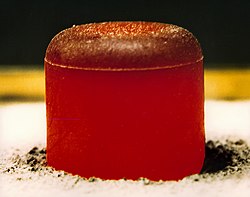Actinide
The actinide series is the 15 chemical elements between actinium and lawrencium on the periodic table. They have the atomic numbers between 89 and 103. The actinide series is named after actinium. All of the elements are radioactive. Uranium is the most common natural actinide, and thorium second.[1]
The term ‘actinide series’ has been derived from the first element of the series, actinium. The symbol An is used while referring to any of the actinide series elements.
All actinide series elements are radioactive in nature, they release a large amount of energy on radioactive decay. Uranium and thorium are the most abundant naturally occurring actinides on earth, whereas plutonium is synthetically obtained.[2]
The actinide elements
| Atomic Number | Name | Symbol | Picture |
|---|---|---|---|
| 89 | Actinium | Ac | − |
| 90 | Thorium | Th | |
| 91 | Protactinium | Pa | − |
| 92 | Uranium | U | |
| 93 | Neptunium | Np | |
| 94 | Plutonium | Pu | 
|
| 95 | Americium | Am | |
| 96 | Curium | Cm | − |
| 97 | Berkelium | Bk | |
| 98 | Californium | Cf | |
| 99 | Einsteinium | Es | 
|
| 100 | Fermium | Fm | − |
| 101 | Mendelevium | Md | − |
| 102 | Nobelium | No | − |
| 103 | Lawrencium | Lr | − |
Actinide Media
Enrico Fermi suggested the existence of transuranium elements in 1934.
Glenn T. Seaborg and his group at the University of California at Berkeley synthesized Pu, Am, Cm, Bk, Cf, Es, Fm, Md, No and element 106, which was later named seaborgium in his honor while he was still living. They also synthesized more than a hundred actinide isotopes.
Unprocessed uranium ore
Monazite: a major thorium mineral
Separation of uranium and plutonium from spent nuclear fuel using the PUREX process
A pellet of 238PuO2 to be used in a radioisotope thermoelectric generator for either the Cassini or Galileo mission. The pellet produces 62 watts of heat and glows because of the heat generated by the radioactive decay (primarily α). Photo is taken after insulating the pellet under a graphite blanket for minutes and removing the blanket.
References
- ↑ Anonymous (2018-04-19). "Properties of Actinide Materials under Extreme Conditions". EU Science Hub - European Commission. Retrieved 2021-11-11.
- ↑ "Actinide - an overview | ScienceDirect Topics". www.sciencedirect.com. Retrieved 2021-11-11.










